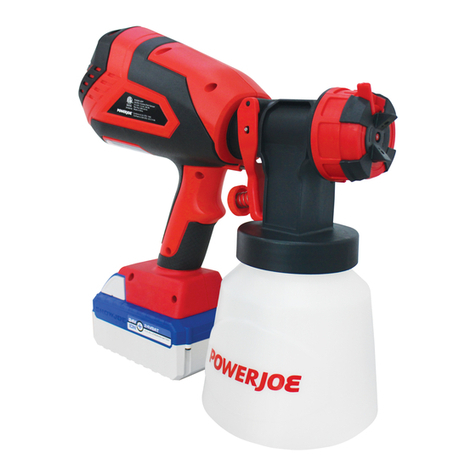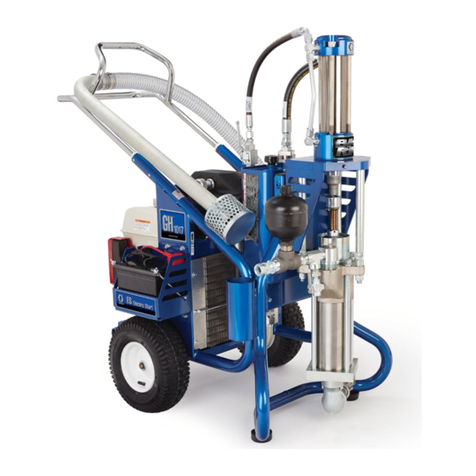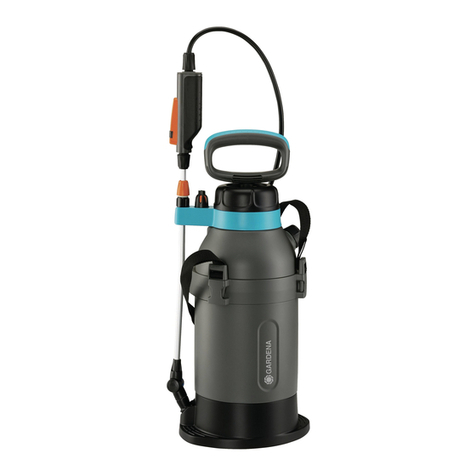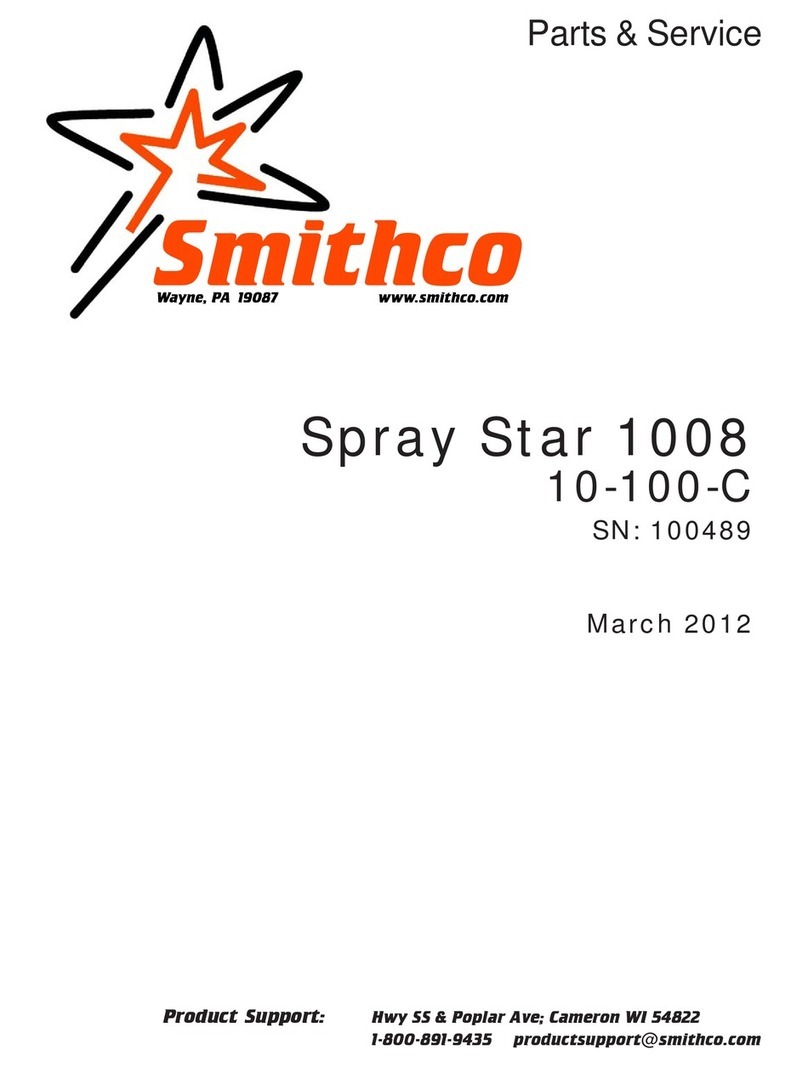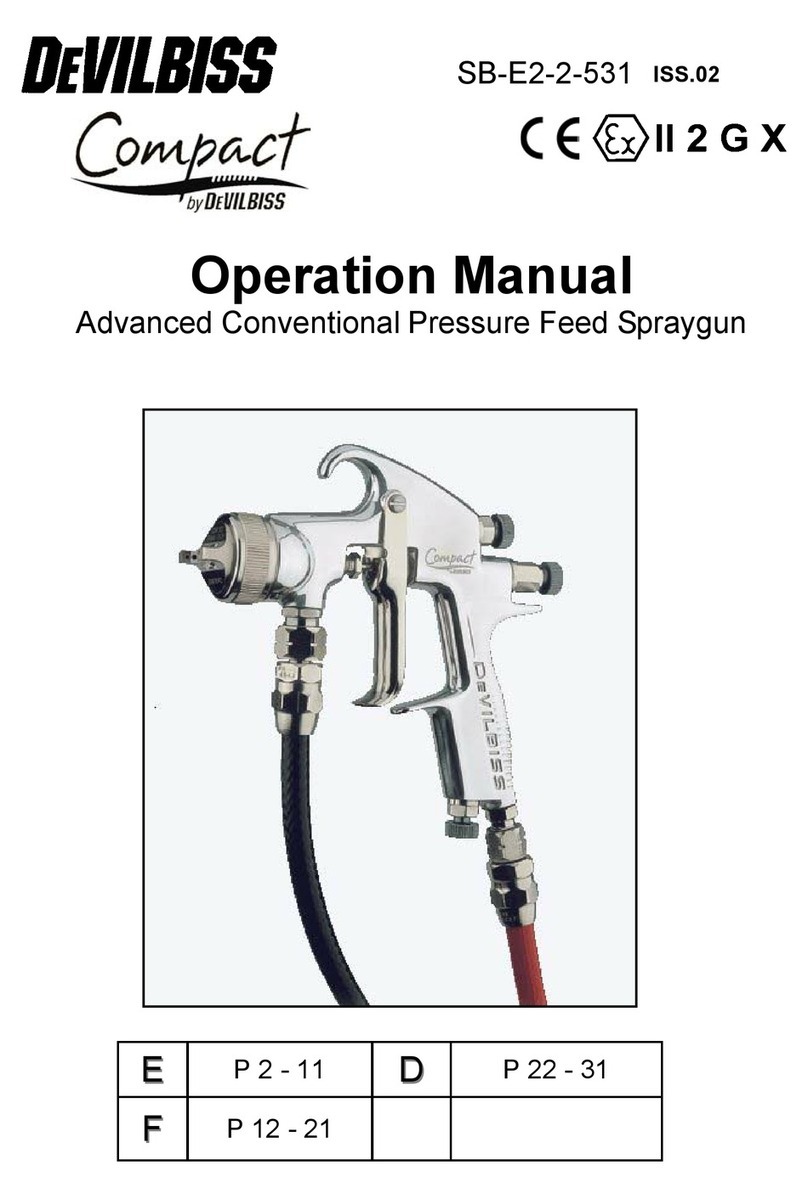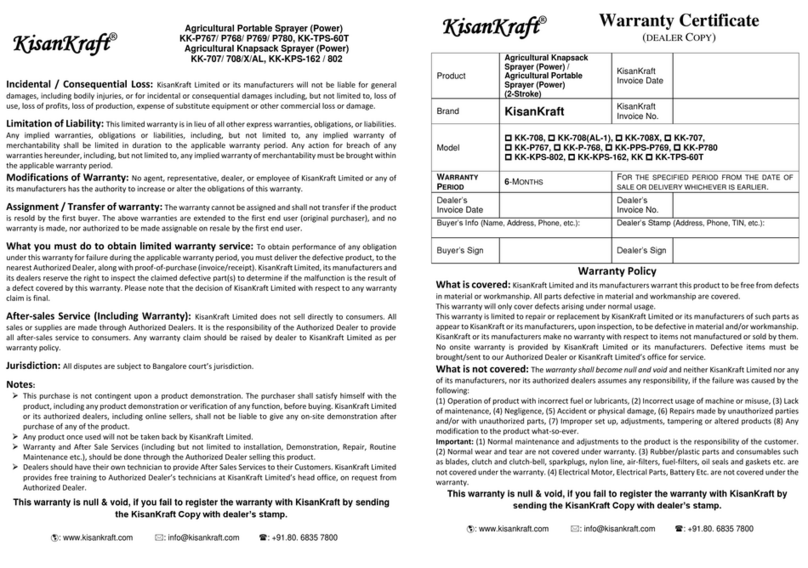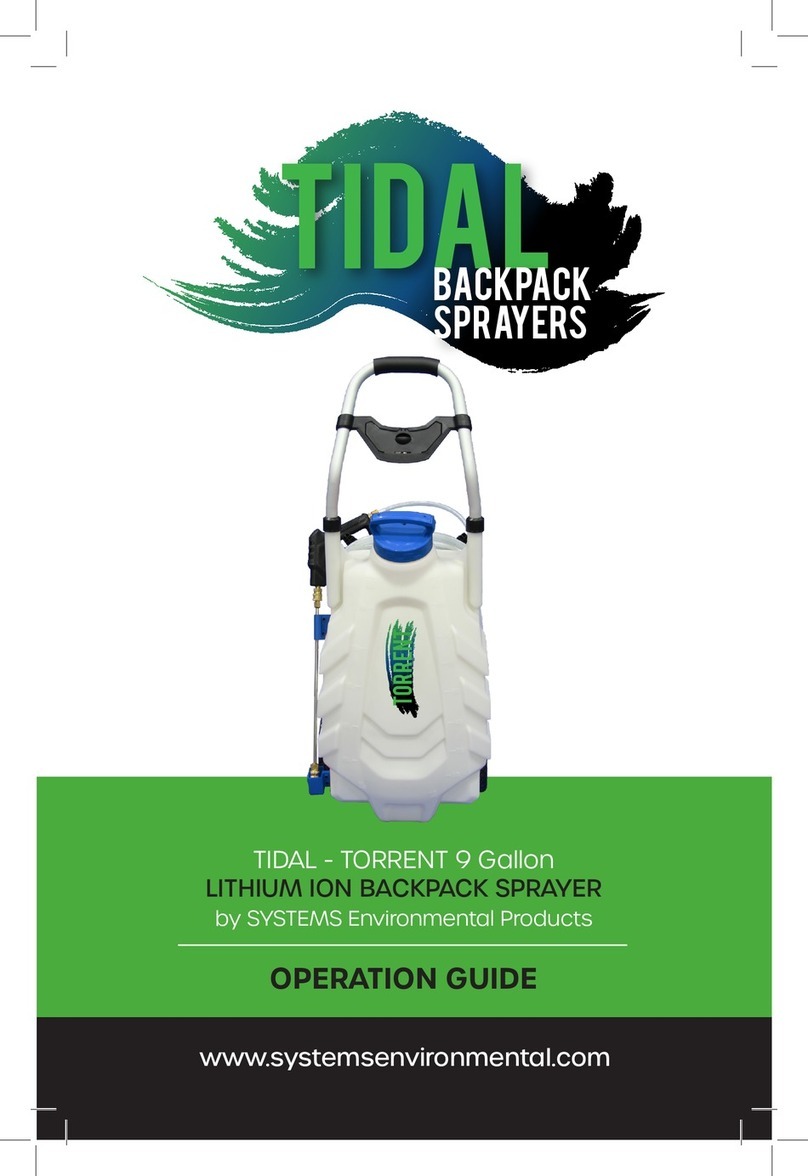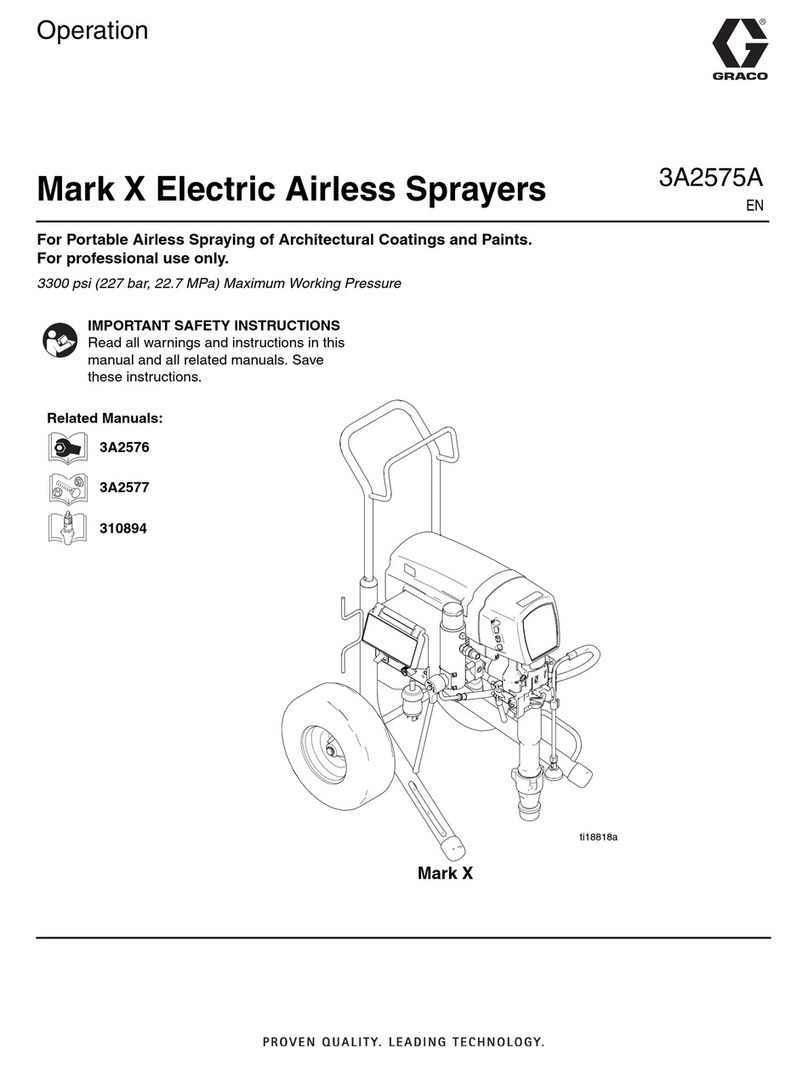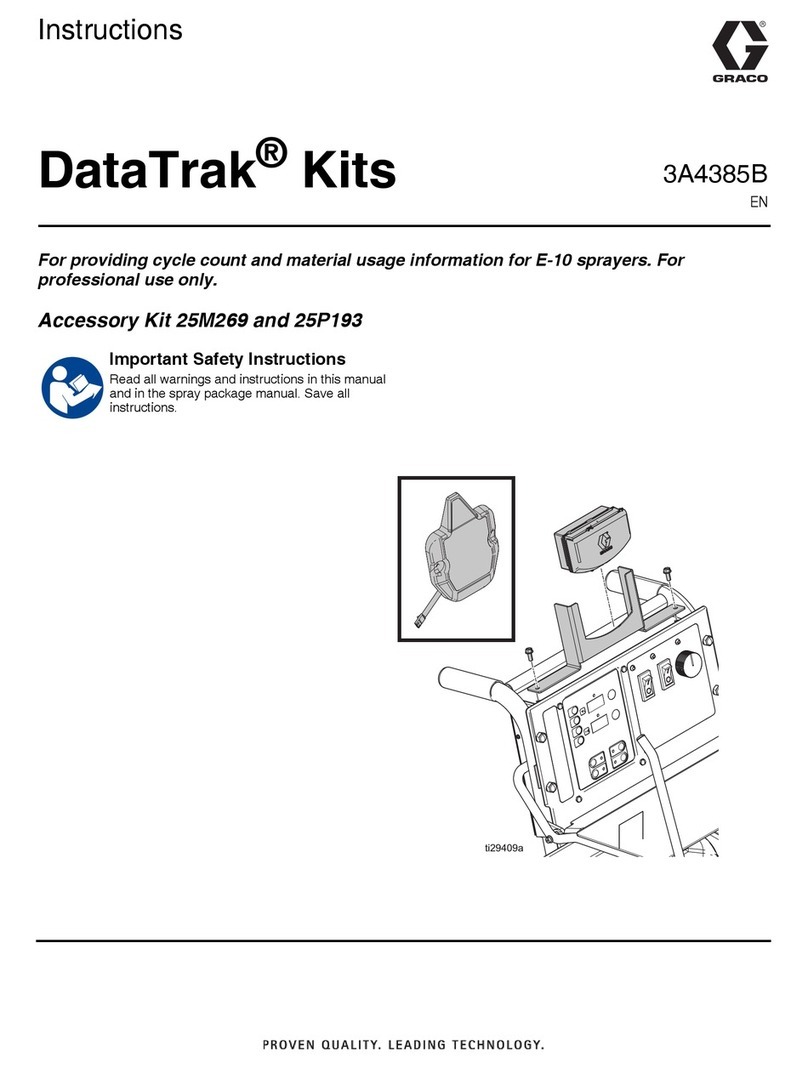Dino-Power DP-X5 User manual

Operation Manual
DP-X3 DP-X5
Electric Airless Paint Sprayer
www.dpairless.com
Important Safety Instructions
Read all warnings and instructions in this manual, related manuals, and on the unit.
Be familiar with the controls and the proper usage of the equipment. Save these
instructions. Read carefully and practice good safety habits.

1
Review Warnings for Important Safety Information.
Not approved for use in explosive atmospheres or hazardous locations.
For portable airless spraying of architectural paints and coatings.
When pump is stored with non-freezing fluid. Pump damage will occur if water or latex
paint freezes in pump.
Damage to plastic parts may result if impact occurs in low temperature conditions.
Changes in paint viscosity at very low or very high temperatures can affect sprayer
performance.
FIRE AND EXPLOSION HAZARD
DP-X3/DP-X5 Models:
•
Use only non-flammable or water-based/oil-based materials, or non-flammable paint thinners. Do
not use materials having flash points lower than 100° F (38° C). This includes, but is not limited to,
acetone, xylene, toluene, or naphtha. For more information about your material, request Safety
Data Sheet (SDS) from the supplier.
•
Spraying flammable or combustible materials in a factory or fixed location must comply with NFPA
33 and OSHA 1910.94(c) requirements in the USA and with all similar local regulations in other
countries.
Before You Spray

2
Contents
Before You Spray.......................................................................................................................... 1
Warnings......................................................................................................................................... 3
Know Your Sprayer.......................................................................................................................6
Setup.................................................................................................................................................7
Start Up............................................................................................................................................ 9
Pressure Relief Procedure.....................................................................................................9
How to Spray................................................................................................................................ 12
Adjust Pressure Control....................................................................................................... 13
Spray Techniques................................................................................................................. 13
Clear Tip Clog........................................................................................................................ 14
Cleanup..........................................................................................................................................15
Storage...........................................................................................................................................17
Reference...................................................................................................................................... 19
Spray Tip Selection............................................................................................................... 19
Cleaning Fluid Compatibility................................................................................................ 20
Static Grounding Instructions (Oil-Based materials)........................................................20
Maintenance................................................................................................................................. 22
Troubleshooting.......................................................................................................................... 25
Explosion View and Spare Parts List.................................................................................... 29
DP Information.............................................................................................................................31
Contents

Warnings
3
Warnings
The following warnings are for the setup, use, maintenance, and repair of this equipment. The
exclamation point symbol alerts you to a general warning and the hazard symbols refer to
procedure-specific risks. When these symbols appear in the body of this manual or on
warning labels, refer back to these Warnings. Product-specific hazard symbols and warnings
not covered in this section may appear throughout the body of this manual where applicable.
FIRE AND EXPLOSION HAZARD
Flammable fumes, such as solvent and paint fumes, in work area can ignite or explode. To help
prevent fire and explosion:
DP-X3/DP-X5 Models:
•
Do not spray or clean with materials having flash points lower than 100°F (38° C). Use only
non-flammable or water-based materials, or non-flammable paint thinners. For complete
information about your material, request the Safety Data Sheet (SDS) from the material
distributor or retailer.
•
Do not spray combustible materials near an open flame or sources of ignition such as
cigarettes, motors, and electrical equipment.
•
Do not spray combustible liquids in a confined area.
•
Do not spray flammable or combustible materials near an open flame or sources of ignition
such as cigarettes, motors, and electrical equipment.
•
Do not spray flammable or combustible liquids in a confined area.
•
Paint or solvent flowing through the equipment is able to result in static electricity. Static
electricity creates a risk of fire or explosion in the presence of paint or solvent fumes. All
parts of the spray system, including the pump, hose assembly, spray gun, and objects in
and around the spray area shall be properly grounded to protect against static discharge
and sparks. Use Graco conductive or grounded high-pressure airless paint sprayer hoses.
•
Verify that all containers and collection systems are grounded to prevent static discharge.
Do not use pail liners unless they are anti-static or conductive.
•
Connect to a grounded outlet and use grounded extensions cords. Do not use a 3-to-2
adapter.
•
Do not use a paint or a solvent containing halogenated hydrocarbons.
•
Keep spray area well-ventilated. Keep a good supply of fresh air moving through the area.
•
Sprayer generates sparks. Keep pump assembly in a well ventilated area a least 20 feet
(6.1 m) from the spray area when spraying, flushing, cleaning, or servicing. Do not spray
pump assembly.
•
Do not smoke in the spray area or spray where sparks or flame is present.
•
Do not operate light switches, engines, or similar spark producing products in the spray
area.
•
Keep area clean and free of paint or solvent containers, rags, and other flammable
materials.
•
Know the contents of the paints and solvents being sprayed. Read all Safety Data Sheets
(SDSs) and container labels provided with the paints and solvents. Follow the paint and
solvents manufacturer’s safety instructions.
•
Fire extinguisher equipment shall be present and working.

Warnings
4
SKIN INJECTION HAZARD
High-pressure spray is able to inject toxins into the body and cause serious bodily injury. In the
event that injection occurs, get immediate surgicaltreatment.
•
Do not aim the gun at, or spray any person or animal.
•
Keep hands and other body parts away from the discharge. For example, do not try to stop
leaks with any part of the body.
•
Always use the nozzle tip guard. Do not spray without nozzle tip guard in place.
•
Use DP nozzle tips.
•
Use caution when cleaning and changing nozzle tips. In the case where the nozzle tip clogs
while spraying, follow the Pressure Relief Procedure for turning off the unit and relieving
the pressure before removing the nozzle tip to clean.
•
Equipment maintains pressure after power is shut off. Do not leave the equipment
energized or under pressure while unattended. Follow the Pressure Relief Procedure
when the equipment is unattended or not in use, and before servicing, cleaning, or
removing parts.
•
Check hoses and parts for signs of damage. Replace any damaged hoses or parts.
•
This system is capable of producing 2900 psi. Use DPreplacement parts or accessories
that are rated a minimum of 2900 psi.
•
Always engage the trigger lock when not spraying. Verify the trigger lock is functioning
properly.
•
Verify that all connections are secure before operating the unit.
•
Know how to stop the unit and bleed pressure quickly. Be thoroughly familiar with the
controls.
EQUIPMENT MISUSE HAZARD
Misuse can cause death or serious injury.
•
Always wear appropriate gloves, eye protection, and a respirator or mask when painting.
•
Do not operate or spray near children. Keep children away from equipment at all times.
•
Do not overreach or stand on an unstable support. Keep effective footing and balance at
all times.
•
Stay alert and watch what you are doing.
•
Do not operate the unit when fatigued or under the influence of drugs or alcohol.
•
Do not kink or over-bend the hose.
•
Do not expose the hose to temperatures or to pressures in excess of those specified by
DP.
•
Do not use the hose as a strength member to pull or lift the equipment.
•
Do not spray with a hose shorter than 25 feet.
•
Do not alter or modify equipment. Alterations or modifications may void agency approvals
and create safety hazards.
•
Make sure all equipment is rated and approved for the environment in which you are using
it.
ELECTRIC SHOCK HAZARD
This equipment must be grounded.Improper grounding, setup, or usage of the system can
cause electric shock.
•
Turn off and disconnect power cord before servicing equipment.
•
Connect only to grounded electrical outlets.
•
Use only 3-wire extension cords.
•
Ensure ground prongs are intact on power and extension cords.
•
Do not expose to rain. Store indoors.

Warnings
5
PRESSURIZED ALUMINUM PARTS HAZARD
Use of fluids that are incompatible with aluminum in pressurized equipment can cause serious
chemical reaction and equipment rupture. Failure to follow this warning can result in death,
serious injury, or propertydamage.
•
Do not use 1,1,1-trichloroethane, methylene chloride, other halogenated hydrocarbon
solvents or fluids containing such solvents.
•
Do not use chlorine bleach.
•
Many other fluids may contain chemicals that can react with aluminum. Contact your
material supplier for compatibility.
MOVING PARTS HAZARD
Moving parts can pinch, cut, or amputate fingers and other body parts.
•
Keep clear of moving parts.
•
Do not operate equipment with protective guards or covers removed.
•
Pressurized equipment can start without warning. Before checking, moving, or servicing
equipment, follow the Pressure Relief Procedure and disconnect all power sources.
TOXIC FLUID OR FUMES HAZARD
Toxic fluids or fumes can cause serious injury or death if splashed in the eyes or on skin,
inhaled, or swallowed.
•
Read MSDSs to know the specific hazards of the fluids you are using.
•
Store hazardous fluid in approved containers, and dispose of it according to applicable
guidelines.
PERSONAL PROTECTIVE EQUIPMENT
Wear appropriate protective equipment when in the work area to help prevent serious injury,
including eye injury, hearing loss, inhalation of toxic fumes, and burns. This protective
equipment includes but is not limited to:
•
Protective eyewear, and hearing protection.
•
Respirators, protective clothing, and gloves as recommended by the fluid and solvent
manufacturer.

Know Your Sprayer
6
O
H
G
D
J
I
F
C
E
DP-X3 DP-X5
A
Prime/Spray Valve
B
Pressure Control Knob
C
ON/OFF Switch
D
Suction Tube
E
Drain Tube
F
Airless Spray Gun
G
Reversible Spray Tip
H
Tip Guard
I
Gun Trigger Lock
J
Gun Fluid Inlet Fitting
K
Gun Fluid Filter(inside handle)
L
Pump
M
Pump Fluid Outlet Fitting
N
Airless Hose
O
Suction Filter
P
Power Cord
Q
Suction Tube Drip Cup
See Quick Reference, page 21 for
more information.
L
B
A
M
N
K
D
Q
P

Know Your Sprayer
7
Technical Specifications:
Model No.
DP-X3
DP-X5
Pressure Controlling
Mechanical
Mechanical
Motor Power
450W
650W
Max. Flow Rate
1.0L/min 0.26GPM
1.4L/min 0.36GPM
Max. Tip Size
0.017”
0.019”
Max. Pressure
200bar/2900psi
200bar/2900psi

Start Up
8
ti26
Setup
Setup
When unpacking sprayer for the first time
or after long term storage perform setup
procedure.
Assemble Your Sprayer
1.
Connect DP airless hose to fluid
outlet. Use wrench to tighten
securely.
6. Turn pressure control knob all the
way left (counter-clockwise) to
lowest set- ting.
2.
Connect other end of hose to gun.
7. After long term storage check
inlet strainer for clogs and debris.
3.
Use two wrenches to tighten securely.
If hose is already connected, make
sure connections are tight.
4.
Engage trigger lock.
5.
Remove tip guard. Be careful tip seal
may fall out when tip guard is
removed.
Strain the Paint
Previously opened paint may contain
dried paint or other debris. To avoid
priming prob- lems and spray tip clogs it is
recommended to strain the paint before
using. Paint strain- ers are available
where paint is sold. Stretch a paint
strainer over a clean pail and pour the
paint through the strainer to capture any
dried paint and debris before spraying.

9
Start Up
Start Up
Pressure Relief Procedure
Follow the Pressure Relief
Procedure whenever you see this
symbol.
This equipment stays pressurized until
pressure is manually relieved. To help
prevent serious injury from pressurized
fluid, such as skin injection or splashed
fluid, follow the Pressure Relief
Procedure whenever sprayer is stopped
and before sprayer is cleaned or checked,
and before equipment is serviced.
1. Turn ON/OFF switch to the OFF
position.
1.
Engage the trigger lock. Always engage
the trigger lock when sprayer is stopped
to prevent the gun from being triggered
accidentally.
2.
Turn pressure control knob to
lowest setting.
3.
Put drain tube into a waste pail and
turn Prime/Spray valve in PRIME
position (drain) to relieve pressure.
4.
Hold the gun firmly to a pail. Point
gun into pail. Disengage the trigger
lock and trigger the gun to relieve
pressure.
5.
Engage the trigger lock.

10
Start Up
6.
If you suspect the spray tip or hose
is clogged or that pressure has not
been fully relieved:
a.
VERY SLOWLY loosen the tip
guard retaining nut or the hose
end coupling to relieve pressure
gradually.
b.
Loosen the nut or
coupling completely.
c.
Clear airless hose or spray tip
obstruction.
1.
Turn Prime/Spray valve
down to PRIME position.
2.
Plug power supply cord into a
properly grounded electrical outlet.
3.
Align setting indicator with
Prime/Clean setting on pressure
control knob.
4.
Turn ON/OFF switch to ON position.

How to Spray
11
B
5.
When sprayer starts pumping, flushing
solvent and air bubbles will be purged
from system. Allow fluid to flow out of
drain tube, into waste pail, for 30 to 60
seconds.
6.
Turn ON/OFF switch to OFF position.
High-pressure spray is able to inject toxins
into the body and cause serious bodily
injury. Do not stop leaks with hand or rag.
7.
Inspect for leaks. If leaks occur, per-
form Pressure Relief Procedure, page
9, then tighten all fittings and repeat
Start Up. If there are no leaks continue
with the next step.
Fill Pump
1. Move suction tube to paint pail and
submerge suction tube in paint.
NOTE: Some fluids may prime faster
if the ON/OFF Switch is momentarily
turned off so the pump can slow and
stop. Turn ON/OFF switch on and off
several times if necessary.
Fill Gun and Hose
1.
Hold gun against waste pail. Point
gun into waste pail.
a.
Disengage trigger lock.
b.
Pull and hold gun trigger.
c.
Turn Prime/Spray valve
horizontal to SPRAY position.
d.
Turn ON/OFF switch to ON
posi- tion.
A
C
D
2.
Turn ON/OFF switch to ON position.
3.
Wait to see paint coming out of drain
tube.
4.
Turn ON/OFF switch to OFF position.
2.
Trigger gun into waste pail until
only paint comes out of the gun.
3.
Release trigger. Engage trigger lock.
4.
Transfer drain tube to paint pail and
clip to suctiontube.
NOTE: When motor stops, sprayer is
ready to paint. If motor continues to run,
sprayer is not properly primed. Repeat
Fill Pump and Fill Gun and Hose.
Start Up

How to Spray
12
How to Spray
Spray Tip Installation
To prevent spray tip leaks make certain
spray tip and tip guard are installed
properly.
1.
Perform Pressure Relief
Procedure, page 9.
2.
Engage trigger lock.
3.
Verify spray tip and tip guard parts
are assembled in the order shown.
a.
Use spray tip to align gasket
and seal in the tip guard.
b.
Spray tip must be pushed all the way
into the tip guard. Turn spray tip to
push down.
c.
Turn the arrow shaped handle on
the spray tip forward to the spray
position.
4.
Screw spray tip and tip guard assembly
onto the gun and tighten.

13
How to Spray
Adjust Pressure Control
The pressure control knob allows for infinite pressure adjustment. To reduce overspray, always
start at the lowest pressure setting and increase pressure to the minimum setting that results
in an acceptable spray pattern.
2900 psi
(200 bar, 20 MPa)
1500 psi
(103 bar, 10.3 MPa)
500 psi
(34.5 bar, 3.5 MPa)
ti5597b
To select function, align symbol on pressure control knob with setting indicator on sprayer.
Tip and Pressure Selection
See table for recommended spray pressure for your material. Refer to paint (material) can for
manufacturer’s recommendations.
Maximum tip hole sizes supported by the sprayer:
DP-X3: 0.017 in. (0.43 mm)
DP-X5: 0.019 in. (0.48 mm)
Coatings
Interior
Stains/
Interior &
Exterior
Clears
Exterior
Solid Stains
Primers
Interior Latex
Paints
Exterior Latex
Paints
Spray Pressure
Low Spray
High Spray
High spray
High Spray
High Spray
Tip hole Size
0.011 in. (0.28 mm)
X
0.013 in. (0.33 mm)
X
X
X
X
0.015 in. (0.38 mm)
X
X
X
X
0.017 in. (0.43 mm)
X
X
X
0.019 in. (0.48 mm)
X
Spray Techniques
Use a piece of scrap cardboard to practice
these basic spraying techniques before you
begin spraying the surface.
•
Hold gun 12 in. (30 cm) from surface
and aim straight at surface. Tilting gun
to direct spray angle causes an uneven
12 in.
(30 cm)
EVEN
FINISH
THICK
UNEVEN
FINISH
THIN
finish.
•
Flex wrist to keep gun pointed straight.
Fanning gun to direct spray at angle
causes uneven finish.
EVEN FINISH THIN
THICK
THIN

How to Spray
14
How to Spray
Triggering Gun
Pull trigger after starting stroke. Release
trigger before end of stroke. Gun must be
moving when trigger is pulled and
released.
TI2037A
Aiming Gun
Aim center of spray of gun at bottom edge
of previous stroke, overlapping each
stroke by half.
Spray Pattern Quality
A good spray pattern is evenly distributed
as it hits the surface.
•
Spray should be atomized (evenly
dis- tributed, no gaps at edges).
If tails persist when spraying at the highest
spray pressure:
•
Spray tip may be worn. See Tip
and Pressure Selection, page13.
•
A smaller spray tip may be needed.
•
Material may need to be thinned. If
material needs to be thinned follow
manufacturer’s recommendations.
Clear Tip Clog
In the event that particles or debris clog the
spray tip, this sprayer is designed with a
reversible spray tip that quickly and easily
clears the particles without disassembling the
sprayer.
See Strain the Paint, page 8 for additional
information.
1.
Engage trigger lock. Rotate spray tip to
unclog position. Disengage trigger lock.
Trigger gun at waste area to clear clog.
UNCLOG
NOTE: If spray tip is difficult to rotate when
turning to the unclog position perform,
Pressure Relief Procedure, page 9, then
turn Prime/Spray valve to spray position and
repeat step 1.
2.
Engage trigger lock. Rotate spray tip
back to spray position. Disengage trig-
ger lock and continue spraying.
SPRAY
tails- gaps
at edges
good
spray pattern
pressure
too low

Cleanup
15
Cleanup
Cleanup
Cleaning the sprayer after each use results in
a trouble free start up the next time the
sprayer is used.
Cleaning from a Pail
•
For short term shutdown periods (over-
night to two days) refer to Short Term
Storage, page 17.
•
See Cleaning Fluid Compatibility,
page 20 for information on flush-
ing/cleaning fluids and Static Ground-
ing Instructions (Oil-Based
materials), page 20.
1.
Perform Pressure Relief Procedure,
page 9.
2.
Remove spray tip and tip guard assem-
bly from gun and place in waste pail.
3.
Lift suction tube and drain tube from
paint pail. Let paint drain into the pail.
4.
Separate drain tube (smaller) from suc-
tion tube (larger).
5.
Place empty waste and flushing fluid
pails side by side.
6.
Place suction tube in flushing fluid. Use
water for water based paint and mineral
spirits or compatible oil-based flushing
solvent for oil-based paint. Place drain
tube in waste pail.
7.
Turn pressure control knob to the
Prime/Clean setting.
8.
Turn Prime/Spray valve down to
PRIME position.
9.
Turn ON/OFF switch to ON position.
10.
Flush until approximately 1/3 of the
flushing fluid is emptied from the pail.

16
11.
Turn ON/OFF switch to OFF position.
NOTE: Step 12 is for returning paint in
hose to paint pail. One 50 ft (15 m) hose
holds approximately 1 quart (1 liter) of
paint.
12.
To recover paint in hose, point gun
into paint pail while holding gun firmly
to the pail.
a.
Disengage trigger lock.
b.
Pull and hold gun trigger.
c.
Turn Prime/Spray valve
horizontal to SPRAY position.
d.
Turn ON/OFF switch to ON
position.
e.
Continue to hold gun trigger
until you see paint diluted with
flushing fluid starting to come
out of gun.
13.
While continuing to trigger gun,
quickly move gun to redirect spray
into waste pail. Continue triggering
gun intowaste pail until flushing fluid
dispensed from gun is relatively clear.
14.
Turn pressure control knob to the
low- est setting.
15.
Stop triggering gun. Engage the
trigger lock.
Turn Prime/Spray valve down to
PRIME position.
16.
Turn ON/OFF switch to OFF position.
Clean the Gun
1. Clean gun fluid filter with water or
flushing fluid and a brush every time you flush
the system. Replace gun filter if damaged.
2. Remove spray tip and tip guard and
clean with water or flushing fluid and a
brush.
3. Wipe paint off outside of gun using a soft
cloth moistened with water or flushing fluid.
A
C
D
Cleanup

17
ti27187a
Storage
Storage
With proper storage, the sprayer will be ready
to use the next time it is needed.
Short Term Storage
(up to 2 days)
1.
Perform Pressure Relief Procedure,
page 9.
2.
Leave suction tube and drain tube in
paint pail.
3.
Cover paint and pail tightly with plastic
wrap.
4.
Engage trigger lock.
5.
Leave gun attached to hose.
6.
Remove tip and guard and clean with
water or flushing fluid and a brush.
7.
Wipe paint off outside of gun using a
soft cloth moistened with water or flush-
ing fluid.
Long Term Storage
(more than 2 days)
Pump armor fluid protects the sprayer
against freezing and corrosion.
•
Before storing sprayer make sure all
water is drained out of sprayer.
•
Do not allow water to freeze in sprayer.
•
Do not store sprayer under pressure.
•
Store sprayer indoors.
1.
Perform Pressure Relief Procedure,
page 9.
2.
Place suction tube in Pump Armor fluid
bottle and drain tube in waste pail.

18
Storage
3.
Turn Prime/Spray valve down
to PRIME position.
4.
Turn ON/OFF switch to ON position.
5.
Turn pressure control knob
clockwise until the pump turns on.
6.
When storage fluid comes out of
drain tube (5-10 seconds) turn
ON/OFF switch to OFF position.
7.
Turn Prime/Spray valve horizontal to
SPRAY position to keep storage fluid
in sprayer during storage.
8.
Leave gun attached to hose.
9.
Remove tip and guard and clean with
water or flushing fluid and a brush.
10.
Wipe paint off outside of gun using a
soft cloth moistened with water or flush-
ing fluid.
11.
Secure a plastic bag around suction
and drain tube to catch any drips.

Reference
19
Reference
Spray Tip Selection
Selecting Tip Size
Spray tips come in a variety of hole sizes for
Understanding Tip Number
The last three digits of tip number (i.e.:413)
contain information about hole size and fan
width on surface when gun is held 12 in.
(30.5 cm) from surface being sprayed.
First digit when doubled
= approximate 413 tip has
spraying a range of fluids. Your sprayer
includes a tip for use in most paint spraying
applications. Use the coatings table on page
17 to determine the range of recommended
tip hole sizes for each fluid type. If you need
a tip other than the one supplied, see the
Reversible Spray Tip Selection Chart.
fan width.
8-10 in. (20-25 cm)
fan width.
413 tip has
a 0.013 in.
hole size
Hints:
•
As you spray, the tip wears and
enlarges. Starting with a tip hole size
smaller than the maximum will allow
you to spray within the rated flow
capacity of the sprayer.
•
Use larger tip hole sizes with thicker
coatings and smaller tip hole sizeswith
thinner coatings.
•
Tips wear with use and need periodic
replacement.
•
Tip hole size controls flow rate - the
amount of paint that comes out of the
gun.
Fan Width
Fan width is the size of the spray pattern,
which determines the area covered with each
stroke.
Hints:
•
Select a fan width best suited to the
surface being sprayed.
•
Wider fans allow provide better cover-
age on broad, open surfaces.
•
Narrower fans provide better control on
small, confined surfaces.
Last two digits = tip hole size in thousands of an inch.
Reversible Spray Tip
Selection Chart
DP Tip #
Fan Width *
Hole Size
DP-637TT
DP-637TX
DP-637T5
6 - 8 in.
(152 - 203 mm)
0.011 in.
(0.28 mm)
8 - 10 in.
(203 - 254 mm)
0.011 in.
(0.28 mm)
6 - 8 in.
(152 - 203 mm)
0.013 in.
(0.33 mm)
8 - 10 in.
(203 - 254 mm)
0.013 in.
(0.33 mm)
8 - 10 in.
(203 - 254 mm)
0.015 in.
(0.38 mm)
10 - 12 in.
(254 - 305 mm)
0.015 in.
(0.38 mm)
8 - 10 in.
(203 - 254 mm)
0.017 in.
(0.43 mm)
10 - 12 in.
(254 - 305 mm)
0.017 in.
(0.43 mm)
12 - 14 in.
(305 - 356 mm)
0.019 in.
(0.48 mm)
* – 12 in. (305 mm) from surface
Example: For an 8 to 10 in. (203 to 254 mm)
fan width and 0.013 (0.33 mm) hole size.
This manual suits for next models
1
Table of contents
Other Dino-Power Paint Sprayer manuals
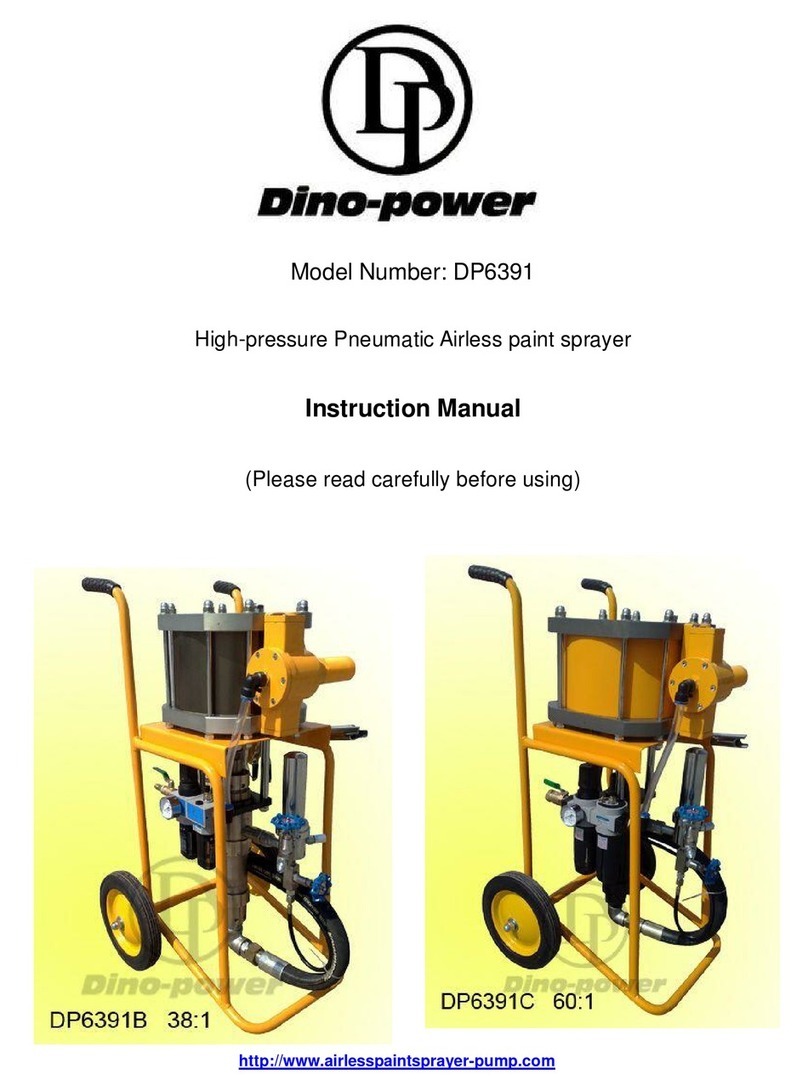
Dino-Power
Dino-Power DP6391C User manual
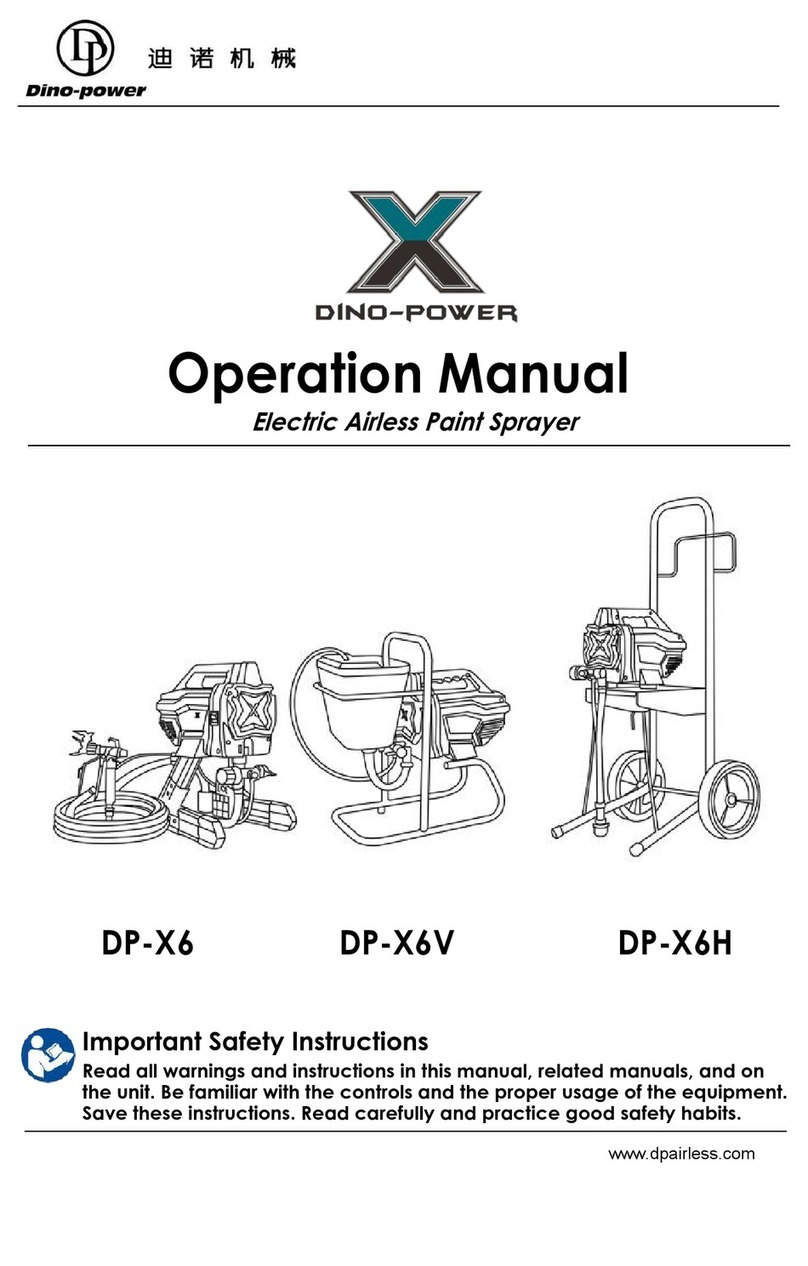
Dino-Power
Dino-Power DP-X6 User manual
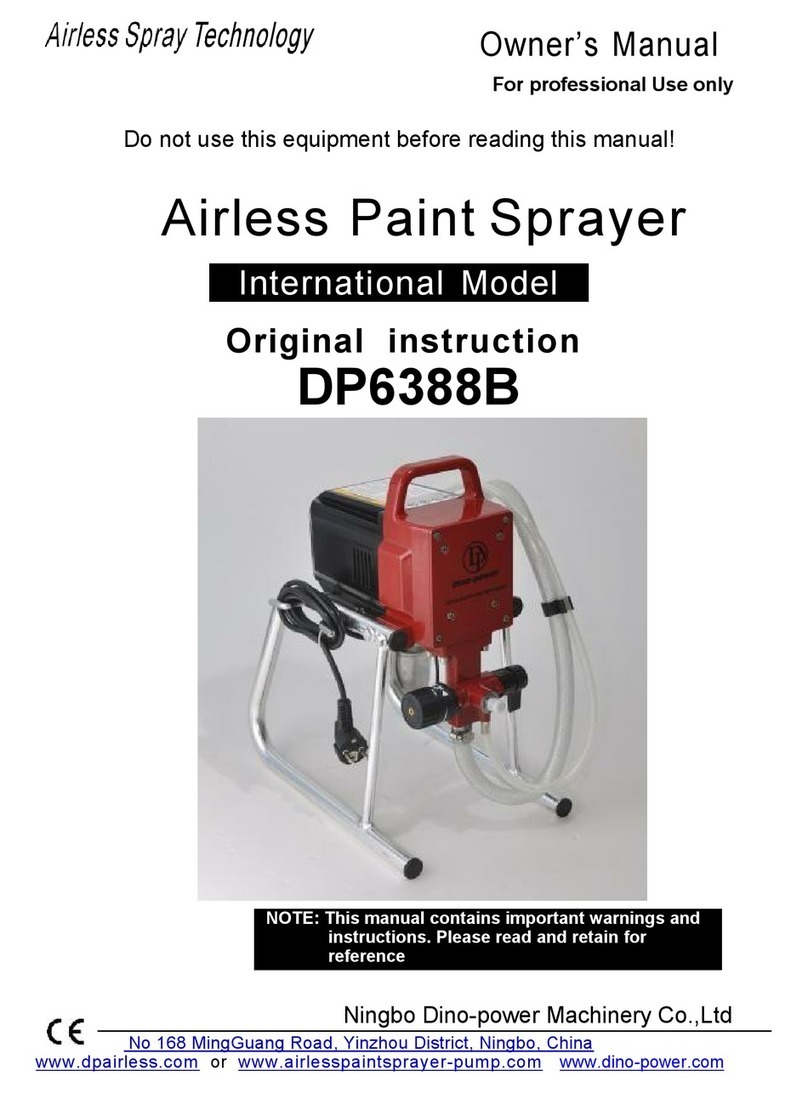
Dino-Power
Dino-Power DP6388B Operation instructions
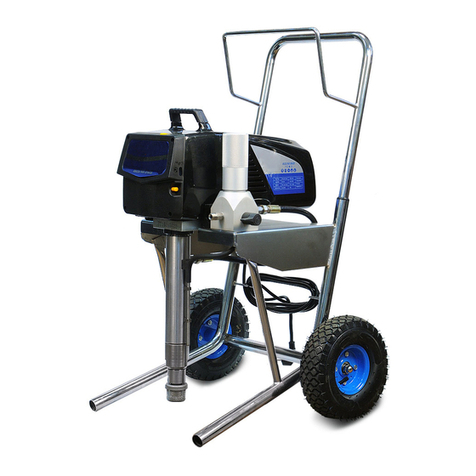
Dino-Power
Dino-Power DP-6336iB User manual
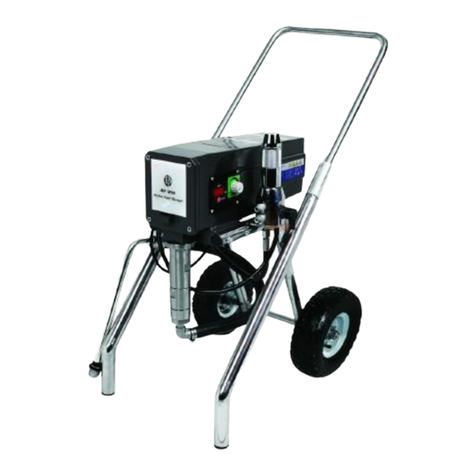
Dino-Power
Dino-Power DP-6840iB User manual
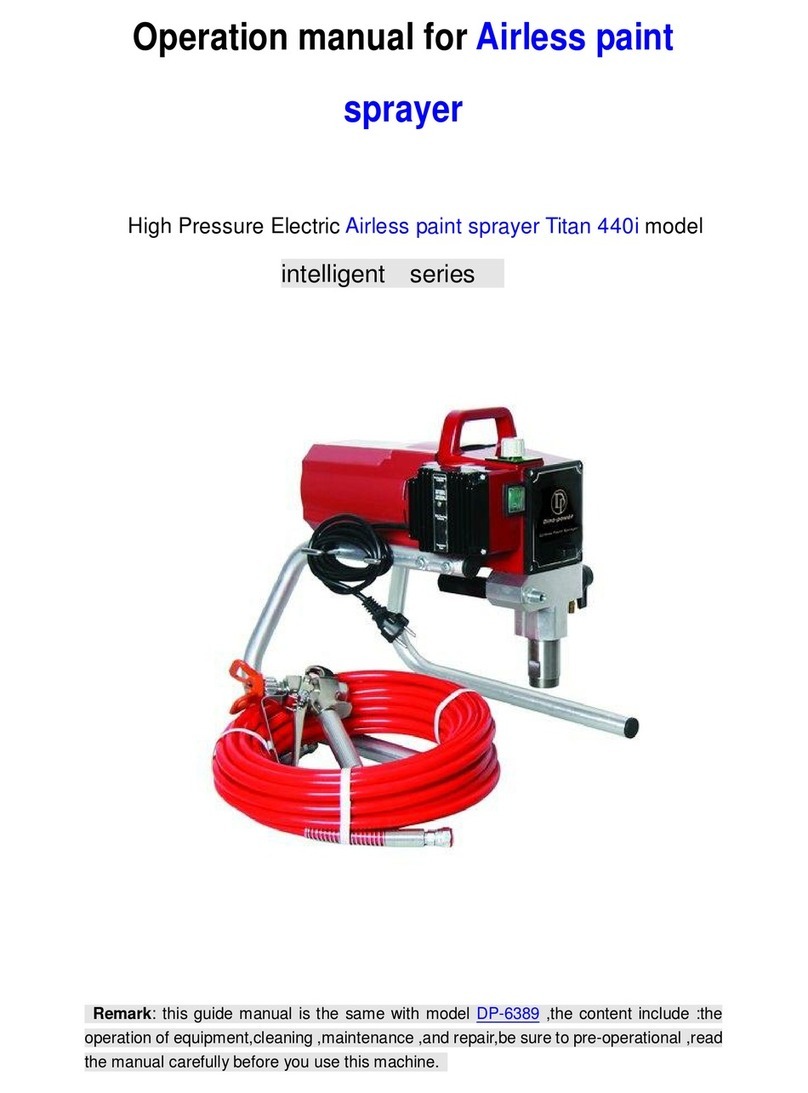
Dino-Power
Dino-Power Titan 440i User manual
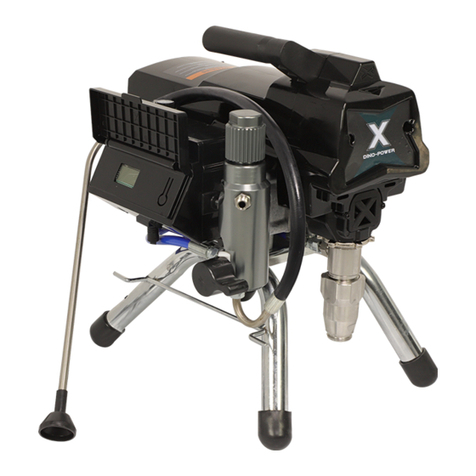
Dino-Power
Dino-Power DP-X Series User manual
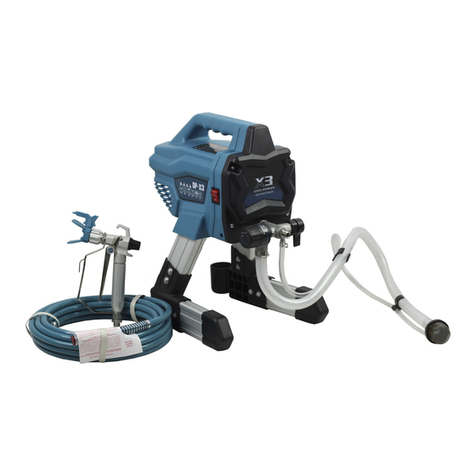
Dino-Power
Dino-Power DP-X3 User manual

Dino-Power
Dino-Power DP-X Series User manual
